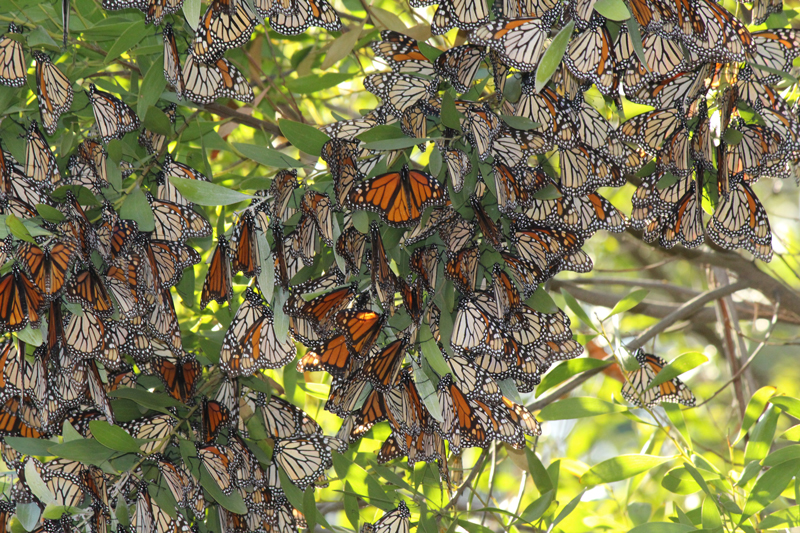As the days get shorter and monarchs make their way to the forested groves along the California coast to settle in for the winter, volunteers for the Xerces Society Western Monarch Thanksgiving Count are preparing to head out to observe and monitor this migratory phenomenon. This year is particularly exciting because it marks the 20thtime the count has been done!
Overwintering monarch clusters first became known to Western science 200 years ago when a Russian expedition landed in San Francisco Bay in October 1816 and collected a single butterfly. Since then, monarchs have been observed overwintering at over 400 locations up and down the Pacific coast stretching from Mendocino County, California to Baja, Mexico. Monarchs from as far away as Idaho, Washington, and Arizona converge to cling to the branches of Monterey cypress, Monterey pine, and nonnative eucalyptus in groves along the coast during October and November. They rely on the calm, humid environment the groves provide to weather winter storms. Because they cluster in groups of tens, hundreds, thousands, or even tens of thousands, the overwintering season also provides a convenient opportunity to count the butterflies—a useful metric of the size of western monarch population.
The Western Monarch Thanksgiving Count (also known as the WMTC) is the longest running and most comprehensive effort to monitor overwintering monarchs in California. During a designated three-week period centered on Thanksgiving, volunteers count the butterflies and assess the condition of the habitat they rely on. There are currently 299 sites that are part of the WMTC with between a third and two thirds of those sites monitored in any single year. Visiting one to two hundred sites over five hundred miles of coast in a three-week period is no easy feat, and it takes the efforts of over a hundred volunteers.

However, the origins of the count were much humbler. Twenty years ago, the WMTC was started due to the dedication of three passionate biologists: Dennis Frey, David Marriott, and Mia Monroe. Each had been involved in monarchs in California for years, regularly visiting overwintering sites and drumming up local interest along with other early monarch pioneers Walt Sakai and Robert Michael Pyle. However, by the mid-1990s the biologists had started to become concerned that monarch populations appeared to be declining. To understand if this trend was continuing or just part of the normal up-and-down cycle of butterfly populations, they initiated a “Thanksgiving Count” in the fall of 1997 by counting monarchs at 101 locations. Founder of the WMTC, Mia Monroe explained that the Thanksgiving Count arose as an important tool for documentation and increasingly it became a focal point of information sharing. WMTC participants initiated conversations about everything from roost trees to the best approaches to reach land-owners, and were able to keep in touch with legendary researchers of the monarch world such as John Lane and Kingston Leong.
Over the years, the WMTC has grown in size and scope, and the coordinators seek to balance increasing volunteer participation with maintaining scientific integrity. The WMTC still retains its grass-roots style of citizen science with twelve dedicated regional coordinators who organize local monitoring efforts in counties throughout the monarchs’ overwintering range. These regional coordinators include experienced lepidopterists and monarch enthusiasts who volunteer their time to monitor sites they have been visiting for years or even decades as well as train new volunteers. As Mia Monroe puts it, “I am proud to see the counts but also the immediate connection to the monarch, the place, and the other devoted field biologists who make commitments to get out to the chilly coast to look for a cloud of fluttering orange and black butterflies, take the time to count, then turn around and share the methodology with others.”
Monarch populations, like many insects, naturally fluctuate from year-to-year due to factors such as weather. So it took many years of monitoring to confirm what the three biologists suspected back in 1997—monarch numbers have declined at overwintering sites in California. A report based on data gathered through the WMTC, State of the Monarch Butterfly Overwintering Sites in California was published by the Xerces Society this summer. The analysis of the data shows a 74% decline in the number of monarchs which overwinter along the California coast since the late 1990s. This significant loss of monarchs mirrors the troubling trend (~80% decline) seen at overwintering sites in central Mexico as well as in summer butterfly surveys in Northern California.

As we begin the 20th year of the WMTC, we know our work is more important than ever. Monarchs, the iconic and once ubiquitous butterfly, are in trouble across North America and this reflects the dire state of many other butterflies, bees, beneficial insects, and wildlife species. Reversing these trends will require conservation action ranging from grass-roots groups, gardeners, farmers, policy-makers, and scientists. And long-term monitoring of wildlife populations, such as the WMTC, will continue to be some of the most telling measures of the health of our ecosystems.
This year, the official Western Monarch Thanksgiving Count period runs from Saturday November 12th through Sunday December 4th. If you are interested in joining as a citizen scientist, you can find an overwintering site near you and sign up to monitor on our website. We are also on Facebook and now on the Monarch SOS app from NatureDigger (available for iOS only; free from iTunes).



